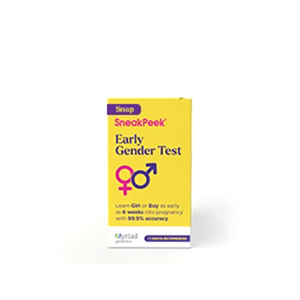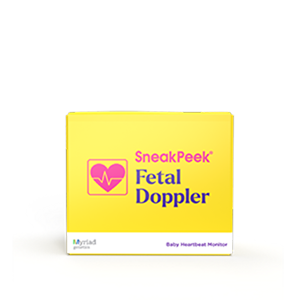Published on August 26th, 2021 and Updated on January 15th, 2024
Check out SneakPeek Gender Test to find out your baby’s gender as early as 6 weeks at over 99% accuracy1!
One of the most rewarding aspects of being a parent is introducing your baby to all the surprising, delightful, and delicious treats the world has to offer. From the magnetic energy of a furry brother or sister to the mesmerizing wonder of a game of peek-a-boo, everything is an exciting new experience for your little bundle of joy.
When it comes to food, introducing your baby to tasty new food flavors is sure to result in lip-smacking grins. But before you expand your baby’s daily menu, you may need to ask a few questions like when can babies have salt, when can babies have chocolate, or when can babies have cheerios?
However, many parents like to start with introducing their babies to fresh and organic food like strawberries.
So, when can babies have strawberries?
Generally, your baby can start eating strawberries when she’s around 6 months old. To understand the best ways to introduce this sweet snack into your baby’s diet, take a look below at our strawberry-serving strategies and tips.
Introducing Strawberries to Your Baby
Before surprising your baby with a juicy strawberry, consider asking yourself the following questions to make sure your little muncher is ready for this solid snack:
- Does my baby have good control over his head and neck?
- Can he sit upright in his highchair without support?
- Is he able to open his mouth wide?
These are signs that your little one is ready to start exploring the world of solid foods. If you’ve answered yes to these questions, your baby can take his first steps down strawberry lane. Start slowly and be sure not to serve strawberries together with other new food items. That way if an adverse reaction occurs, you’ll know the strawberries were the culprit. Luckily, strawberries are yummy enough to be served on their own.
Precautions to Take When Introducing Strawberries
When introducing your baby to any new food, it’s important to make sure she’s sitting upright in her highchair (to minimize the risk of choking) and that you’re within arm’s reach (in case she does begin to choke).
It’s also critical to look out for any food allergy reactions. Reactions can range from mild to severe and can also include:
- Swelling of the face
- Rashes
- Itching
- Wheezing or trouble breathing
- Vomiting
- Diarrhea
Fortunately, a strawberry allergy is not particularly common. While 8% of children in the U.S. suffer from allergies, 90% of those allergies are due to peanuts, tree nuts, milk, fish, eggs, shellfish, soy, and wheat, leaving fresh strawberries in the minority.
However, an allergic reaction is always a possibility, especially if:
- Your baby has already been diagnosed with a food allergy – Being diagnosed with a food allergy increases your baby’s likelihood of having another food allergy. Approximately 33% of individuals diagnosed with a food allergy have reactions to more than one type of food.
Because strawberries are part of the Rosaceae family, along with peaches, cherries, apples, blackberries, and raspberries, an allergy to any of these foods may also indicate an allergy to strawberries.
- You have a family history of food allergy or strawberry allergy –Some studies suggest that the likelihood of developing an allergy is based 80% on genetics.
- Your baby suffers from moderate to severe eczema – The presence of eczema in infancy has been linked to a higher likelihood of developing a food allergy. One study found that infants diagnosed with eczema were 11 times more likely to have a peanut allergy by 12 months than infants without eczema.
If any of these apply to your little one, consider talking to your pediatrician before adding strawberries to the menu. Otherwise, simply monitor your baby after her strawberry intake. If she exhibits signs of a mild allergic reaction, such as a rash, call your pediatrician right away. If the reaction is severe and your baby is having trouble breathing, skip the pediatrician and call 911.
It’s important to note that when introducing your baby to fresh strawberries in particular, you may notice a red rash develop around her mouth. While this could be a sign of an allergic reaction, if the rash is contained to just this one area, it’s more likely that her skin is irritated by the strawberry juice’s acidity. If this is the case, there’s no need to worry. Unless your little shortcake shows signs of itchiness or discomfort, she can continue to savor that strawberry sweetness.
Choosing the Best Strawberries
To treat your baby to the most delicious strawberries, look for berries that are bright red, with firm green stems. These are signs of peak ripeness, which not only guarantee juiciness, but also softness that makes these berries easier for your baby to eat.
To limit exposure to yucky pesticides, try to buy organic strawberries. While organic strawberries aren’t completely pesticide-free, the pesticides used in organic farming are derived from natural sources. Non-organic produce, on the other hand, is grown with synthetic pesticide, and non-organic strawberries show some of the highest levels of pesticide residue compared to other types of produce.
This is due in part to increased strawberry consumption. To keep up with strawberry demand year-round, farmers have increased their use of pesticides and chemical growing aids. Plus, strawberries don’t have a protective outer layer the way other fruits do, such as bananas and oranges. This means that pesticides are sprayed directly onto the part of the strawberry that we consume.
By purchasing organic strawberries, you can lower the risk of ingesting synthetic pesticide residue. If your strawberries aren’t organic, thoroughly washing your strawberries before serving them will also help minimize exposure.
Effective Techniques for Washing Strawberries
While thoroughly rinsing strawberries with water can help remove pesticide residue, soaking strawberries in a vinegar, salt water, or baking soda solution is a more effective technique. Take a look below at how to use these ingredients to safely cleanse your strawberries.
- Vinegar wash – Mix together a solution that consists of 8 parts water and 1 part vinegar. Then, soak your berries in the solution for about 15 minutes. To remove any leftover vinegar taste, rinse your berries under cool water after removing them from the solution, and pat them dry.
- Salt water wash – To remove pesticide residue with salt, make a salt water solution, adding 1 teaspoon of salt to every 1 cup of warm water. Let your strawberries soak in this solution for 5 minutes, then rinse them with cool water, and pat them dry.
- Baking soda wash –Studies have also shown that baking soda can effectively remove pesticides from the surface of fruits. To create a baking soda solution, add 1 teaspoon of baking soda to every 2 cups of cold water. Let your strawberries sit in this solution for about 12 minutes, then rinse them, and pat dry.
How to Serve Strawberries to Your Baby
The best way to serve strawberries to your little foodie will depend on his age and your feeding method. For instance, if you’ve been spoon-feeding your little one purees, you can easily make your own fresh strawberry puree to introduce him to this new fruit flavor.
For those practicing baby-led weaning—a method that lets your baby feed himself finger foods—cut up or whole strawberries can make for a perfect gummable snack your baby can enjoy at his leisure. Regardless of your baby’s age and experience with solid foods, it’s always best to stay close while he’s eating to ensure his safety.
Take a look below at our recommended age timeline for serving solid strawberries:
- 6 to 9 months – Slice small strawberries into thin, sheet-like pieces before serving them to your baby to keep them from being a choking hazard. If your baby is having trouble gripping the sliced strawberries between his thumb and forefinger, give him a large strawberry (i.e. larger than a golf ball) that he can easily hold and gnaw on. Just be sure to take the strawberry away when it becomes small enough to fit into his mouth and block his airway.
- 9 to 12 months – By this point, your baby’s ability to grab and hold items will have improved, so try serving sheet-like slices again or chop the strawberry into small pieces. You can also continue to serve your baby whole strawberries if he enjoys munching on them this way.
- 12 to 24 months – To help your older baby practice his fine motor skills, you can serve him bite-size pieces of organic strawberry with a fork. By about 18 months, you can also try presenting strawberry halves he can either eat with a fork or by hand.
Another way to make the strawberry pieces easier to hold is to dust them with baby rice cereal. This not only helps them from slipping out of your baby’s grasp, but also keeps your kitchen floors from becoming a strawberry mess!
Strawberry-Based Recipes for Babies
Once you’ve introduced your growing child to the sweet juicy taste of fresh strawberries, you can start incorporating them into other baby-approved strawberry recipes.
As long as you’re sure there are no allergic reactions to these other ingredients, you can use strawberries to make:
- Oatmeal or yogurt – De-stem fresh strawberries and mash them into a jam. Then add the jam to your baby’s oatmeal or yogurt. Because your homemade jam won’t be filled with excess sugar or preservatives, it makes for a healthy treat.
- Fruity purees – Create your own fruit-filled purees by blending the fresh or frozen strawberries with fresh blueberries for a berry delicious snack or mix strawberries with mango for a tropical treat.
- Compote – Strawberry compote can serve as a yummy addition to oatmeal, yogurt, pancakes, or waffles. Simply simmer sliced strawberries with a bit of fresh orange juice until they reach a thick, jam-like consistency.
- Applesauce – For this recipe, dice up some strawberries and chop peeled apples. Then, mix these ingredients together and simmer them over heat until you have yourself homemade strawberry applesauce.
- Strawberry banana smoothie – Once your baby is over 12 months old, you can safely add milk (either dairy or non-dairy) to the menu. This means delicious organic strawberry banana smoothies are in the picture. Simply blend fresh or frozen strawberries with one ripe banana and the milk of your choice.
The Health Benefits of Strawberries
Not only are strawberries naturally sweet, they’re also an excellent source of vitamins and minerals that can nourish and fuel your baby for hours of exploration, play time, and of course, keeping you on your toes.
In addition to magnesium, potassium and phosphorus, strawberries are also high in:
- Vitamin C – A well-known immune system booster, vitamin C offers an added layer of defense against germs. This is especially useful when your baby reaches her “everything is potentially food” phase. Vitamin C also plays a crucial role in the absorption of iron—an essential mineral in infant neurological development.
- Fiber – Fiber can help support the digestive system and keep your baby regular. And a regular baby is a happy baby (albeit a smelly one).
- Folate – Folate is vital in growing babies, as it assists in the production of DNA and RNA—the body’s genetic building blocks.
- Polyphenols – These powerful antioxidants reduce inflammation and lower oxidative stress which can damage healthy cells.
- Calcium – You may know calcium as the bone building mineral, but it also assists with healthy heart, muscle, and nervous system functions.
- Omega-3 fatty acids – Those itty, bitty strawberry seeds are packed full of healthy omega-3 fatty acids, which are believed to play a crucial role in learning, memory, and brain development.
- Water – Strawberries are composed of about 91% water, helping your little one stay hydrated and full.
Introducing your baby to strawberries can be a delightful and healthful adventure, with the juicy fruit offering a rich source of vital nutrients while also serving as a sweet treat. Always remember to take precautionary measures when starting your baby on solid foods, ensure the strawberries are thoroughly cleaned and served in appropriate sizes for your baby’s age, and monitor for any potential allergic reactions.
Sources:
Healthline. Can Babies Eat Strawberries? https://www.healthline.com/health/parenting/can-babies-eat-strawberries
Solid Starts. Strawberry. https://solidstarts.com/foods/strawberry/#easy-footnote-bottom-2-757
What to Expect. Introducing Strawberries to Your Baby. https://www.whattoexpect.com/first-year/baby-feeding/when-can-babies-eat-strawberries
Medicine Net. Strawberries Have Most Pesticides: Report. https://www.medicinenet.com/script/main/art.asp?articlekey=202177
Parents. 7 Things Parents Should Know About Non-Dairy Milks. https://www.parents.com/recipes/scoop-on-food/things-parents-should-know-about-non-dairy milks/#:~:text=They%20should%20never%20be%20used%20as%20infant%20formulas.&text=Non%2Ddairy%20milks%20are%20not,child%27s%20diet%20after%20age%201.
NCBI. Does Consumption of LC Omega-3 PUFA Enhance Cognitive Performance in Healthy School-Aged Children and throughout Adulthood? Evidence from Clinical Trials. https://www.ncbi.nlm.nih.gov/pmc/articles/PMC4113767/
Healthline. 19 Water-Rich Foods That Help You Stay Hydrated. https://www.healthline.com/nutrition/19-hydrating-foods#TOC_TITLE_HDR_3
EWG. Pesticides + Poison Gases = Cheap, Year-Round Strawberries. https://www.ewg.org/foodnews/strawberries.php
NBC News. What a nutritionist wants you to know about pesticides and produce. https://www.nbcnews.com/better/health/produce-side-pesticides-what-nutritionist-wants-you-know-about-ewg-ncna864156
WebMD. New Hope for Kids With Multiple Food Allergies. https://www.webmd.com/allergies/news/20171212/new-hope-for-kids-with-multiple-food-allergies
Healthline. Do I Have a Strawberry Allergy? https://www.healthline.com/health/strawberry-allergy#crossreactive-foods
Science Daily. Genetic causes of children’s food allergies. https://www.sciencedaily.com/releases/2017/10/171024110707.htm
NCBI. Which infants with eczema are at risk of food allergy? Results from a population-based cohort. https://pubmed.ncbi.nlm.nih.gov/25210971/#:~:text=Conclusion%20and%20clinical%20relevance%3A%20Eczema,months%20than%20infants%20without%20eczema.
Medical News Today. New genetic risk factors for peanut and food allergy identified. https://www.medicalnewstoday.com/articles/319743
CDC. Food Allergies. https://www.cdc.gov/healthyschools/foodallergies/index.htm
Journal of Agricultural and Food Chemistry. Effectiveness of Commercial and Homemade Washing Agents in Removing Pesticide Residues on and in Apples. https://pubs.acs.org/doi/abs/10.1021/acs.jafc.7b03118?source=cen&

Shop Our Products
SneakPeek aims to provide the most accurate and up-to-date information to help our readers make informed decisions regarding their health before, during, and after pregnancy. This article was written based upon trusted scientific research studies and/or articles. Credible information sources for this article are cited and hyperlinked.





